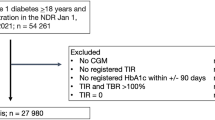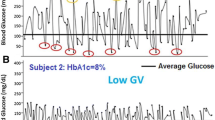Abstract
We investigated the effect of elevated concentrations of fasting plasma glucose (FPG) or hemoglobin A1c (HbA1c) on the risk of development of hypertension among apparently healthy Japanese. Studied were 9584 individuals without known diabetes and hypertension. During a 5-year follow-up period, 1098 individuals developed hypertension. Elevated concentrations of FPG, rather than of HbA1c, were significantly predictive of future hypertension. Compared with the lowest quartile category of FPG (<4.9 mmol l−1), the second (4.9–<5.2 mmol l−1), third (5.2–<5.6 mmol l−1) and highest (⩾ 5.6 mmol l−1) quartile categories had age-, sex- and body mass index-adjusted odds ratios (95% confidence interval) of 1.35 (1.10, 1.66), 1.39 (1.13, 1.71) and 1.85 (1.51, 2.28) for hypertension, respectively. In the highest quartile of FPG, the multivariate-adjusted OR was 1.37 (1.10, 1.70) compared with the lowest quartile. Results of these adjusted models showed no significant association across quartile categories of HbA1c concentrations and an increased risk of developing hypertension. The joint effect of hyperglycemia and overweight, older age or prehypertension resulted in further elevated ORs for hypertension than the absence of such an association. Higher FPG levels rather than HbA1c were strongly predictive of future hypertension among Japanese. Hyperglycemia along with older age, overweight and prehypertension contributed to identifying individuals at increased risk of developing hypertension.

Similar content being viewed by others
References
Ferrannini E, Cushman WC . Diabetes and hypertension: the bad companions. Lancet 2012; 380: 601–610.
Xun P, Liu K, Cao W, Sidney S, Williams OD, He K. Fasting insulin level is positively associated with incidence of hypertension among American young adults: a 20-year follow-up study. Diabetes Care 2012; 35: 1532–1537.
Haffner SM, Valdez R, Morales PA, Mitchell BD, Hazuda HP, Stern MP. Greater effect of glycemia on incidence of hypertension in women than in men. Diabetes Care 1992; 15: 1277–1284.
Klein R, Klein BE, Lee KE, Cruickshanks KJ, Moss SE. The incidence of hypertension in insulin-dependent diabetes. Arch Intern Med 1996; 156: 622–627.
Fagot-Campagna A, Balkau B, Simon D, Ducimetiere P, Eschwege E. Is insulin an independent risk factor for hypertension? The Paris Prospective Study. Int J Epidemiol 1997; 26: 542–550.
Takagi Y, Saitoh S, Tanaka S, Shimamoto K. [Role of impaired glucose tolerance in the progression of hypertension]. Nihon Ronen Igakkai Zasshi 1998; 35: 830–838, in Japanese.
Suematsu C, Hayashi T, Fujii S, Endo G, Tsumura K, Okada K et al. Impaired fasting glucose and the risk of hypertension in Japanese men between the 1980s and the 1990s. The Osaka Health Survey. Diabetes Care 1999; 22: 228–232.
Bjornholt JV, Erikssen G, Kjeldsen SE, Bodegard J, Thaulow E, Erikssen J. Fasting blood glucose is independently associated with resting and exercise blood pressures and development of elevated blood pressure. J Hypertens 2003; 21: 1383–1389.
Levin G, Kestenbaum B, Ida Chen YD, Jacobs Jr DR, Psaty BM, Rotter JI et al. Glucose, insulin, and incident hypertension in the multi-ethnic study of atherosclerosis. Am J Epidemiol 2010; 172: 1144–1154.
Britton KA, Pradhan AD, Gaziano JM, Manson JE, Ridker PM, Buring JE et al. Hemoglobin A1c, body mass index, and the risk of hypertension in women. Am J Hypertens 2011; 24: 328–334.
Bower JK, Appel LJ, Matsushita K, Young JH, Alonso A, Brancati FL et al. Glycated hemoglobin and risk of hypertension in the atherosclerosis risk in communities study. Diabetes Care 2012; 35: 1031–1037.
Morio M, Inoue M, Inoue K, Akimoto K. Impaired fasting glucose as an independent risk factor for hypertension among healthy middle-aged Japanese subjects with optimal blood pressure: the Yuport Medical Checkup Centre retrospective cohort study. Diabetol Metab Syndrome 2013; 5: 81.
Costacou T, Orchard TJ. Differential effect of glycemia on the incidence of hypertension by sex: the epidemiology of diabetes complications study. Diabetes Care 2013; 36: 77–83.
Talaei M, Sadeghi M, Mohammadifard N, Shokouh P, Oveisgharan S, Sarrafzadegan N. Incident hypertension and its predictors: the Isfahan Cohort Study. J Hypertens 2014; 32: 30–38.
Vasan RS, Larson MG, Leip EP, Kannel WB, Levy D . Assessment of frequency of progression to hypertension in non-hypertensive participants in the Framingham Heart Study: a cohort study. Lancet 2001; 358: 1682–1686.
Wang W, Lee ET, Fabsitz RR, Devereux R, Best L, Welty TK et al. A longitudinal study of hypertension risk factors and their relation to cardiovascular disease: the Strong Heart Study. Hypertension 2006; 47: 403–409.
Parikh NI, Pencina MJ, Wang TJ, Benjamin EJ, Lanier KJ, Levy D et al. A risk score for predicting near-term incidence of hypertension: the Framingham Heart Study. Ann Intern Med 2008; 148: 102–110.
Kashiwagi A, Kasuga M, Araki E, Oka Y, Hanafusa T, Ito H et al. International clinical harmonization of glycated hemoglobin in Japan: from Japan Diabetes Society to National Glycohemoglobin Standardization Program values. J Diabetes Investig 2012; 3: 39–40.
Liu CF, Gu YT, Wang HY, Fang NY. Gamma-glutamyltransferase level and risk of hypertension: a systematic review and meta-analysis. PLoS ONE 2012; 7: e48878.
Grayson PC, Kim SY, LaValley M, Choi HK. Hyperuricemia and incident hypertension: a systematic review and meta-analysis. Arthritis Care Res (Hoboken) 2011; 63: 102–110.
WHO Expert Consultation. Appropriate body-mass index for Asian populations and its implications for policy and intervention strategies. Lancet 2004; 363: 157–163.
Boyko EJ, Shaw JE, Zimmet PZ, Chitson P, Tuomilehto J, Alberti KG. A prospective study of glycemia, body size, insulin resistance and the risk of hypertension in Mauritius. J Hypertens 2008; 26: 1742–1749.
Boyko EJ, Barr EL, Zimmet PZ, Shaw JE. Two-hour glucose predicts the development of hypertension over 5 years: the AusDiab study. J Hum Hypertens 2008; 22: 168–176.
Liese AD, Mayer-Davis EJ, Chambless LE, Folsom AR, Sharrett AR, Brancati FL et al. Elevated fasting insulin predicts incident hypertension: the ARIC study. Atherosclerosis Risk in Communities Study Investigators. J Hypertens 1999; 17: 1169–1177.
He J, Klag MJ, Caballero B, Appel LJ, Charleston J, Whelton PK. Plasma insulin levels and incidence of hypertension in African Americans and whites. Arch Intern Med 1999; 159: 498–503.
Bonora E, Tuomilehto J. The pros and cons of diagnosing diabetes with A1C. Diabetes Care 2011; 34 (Suppl 2): S184–S190.
James C, Bullard KM, Rolka DB, Geiss LS, Williams DE, Cowie CC et al. Implications of alternative definitions of prediabetes for prevalence in U.S. Adults. Diabetes Care 2011; 34: 387–391.
Marini MA, Succurro E, Castaldo E, Cufone S, Arturi F, Sciacqua A et al. Cardiometabolic risk profiles and carotid atherosclerosis in individuals with prediabetes identified by fasting glucose, postchallenge glucose, and hemoglobin a1c criteria. Diabetes Care 2012; 35: 1144–1149.
Kim JH, Shin JH, Lee HJ, Kim SY, Bae HY. Discordance between HbA1c and fasting plasma glucose criteria for diabetes screening is associated with obesity and old age in Korean individuals. Diabetes Res Clin Pract 2011; 94: e27–e29.
Lipska KJ, De Rekeneire N, Van Ness PH, Johnson KC, Kanaya A, Koster A et al. Identifying dysglycemic States in older adults: implications of the emerging use of hemoglobin a1c. J Clin Endocrinol Metab 2010; 95: 5289–5295.
Heianza Y, Hara S, Arase Y, Saito K, Fujiwara K, Tsuji H et al. HbA1c 5.7-6.4% and impaired fasting plasma glucose for diagnosis of prediabetes and risk of progression to diabetes in Japan (TOPICS 3): a longitudinal cohort study. Lancet 2011; 378: 147–155.
Kroke A, Liese AD, Keil U, Boeing H. Arterial hypertension and glycemia in non-diabetic subjects: is there an association independent of obesity? Diabetes Metab Res Rev 1999; 15: 99–105.
Pani LN, Korenda L, Meigs JB, Driver C, Chamany S, Fox CS et al. Effect of aging on A1C levels in individuals without diabetes: evidence from the Framingham Offspring Study and the National Health and Nutrition Examination Survey 2001–2004. Diabetes Care 2008; 31: 1991–1996.
Gupta AK, Brashear MM, Johnson WD. Coexisting prehypertension and prediabetes in healthy adults: a pathway for accelerated cardiovascular events. Hypertens Res 2011; 34: 456–461.
Tseng CD, Yen AM, Chiu SY, Chen LS, Chen HH, Chang SH. A predictive model for risk of prehypertension and hypertension and expected benefit after population-based life-style modification (KCIS No. 24). Am J Hypertens 2012; 25: 171–179.
Acknowledgements
All the authors sincerely thank the late Professor and Director Kinori Kosaka, MD, PhD, the Health Management Center, Toranomon Hospital, who established the foundation and framework of this project and was always the foremost pillar of spiritual support of the TOPICS project. This work is financially supported in part by the Ministry of Health, Labour and Welfare, Japan. H Sone and Y Heianza are recipients of a Grant-in-Aid for Scientific Research from the Japan Society for the Promotion of Science. The sponsors had no role in the design and conduct of the study.
Author information
Authors and Affiliations
Corresponding author
Ethics declarations
Competing interests
The authors declare no conflict of interest.
Rights and permissions
About this article
Cite this article
Heianza, Y., Arase, Y., Kodama, S. et al. Fasting glucose and HbA1c levels as risk factors for the development of hypertension in Japanese individuals: Toranomon hospital health management center study 16 (TOPICS 16). J Hum Hypertens 29, 254–259 (2015). https://doi.org/10.1038/jhh.2014.77
Received:
Revised:
Accepted:
Published:
Issue Date:
DOI: https://doi.org/10.1038/jhh.2014.77
- Springer Nature Limited
This article is cited by
-
Association of blood pressure with fasting blood glucose in Indian adults: a secondary data analysis of a clinical, anthropometric, and biochemical survey
Journal of Public Health (2023)
-
The association between glycosylated haemoglobin and newly diagnosed hypertension in a non-diabetic Sudanese population: a cross-sectional study
BMC Cardiovascular Disorders (2022)
-
Associations of the baseline level and change in glycosylated hemoglobin A1c with incident hypertension in non-diabetic individuals: a 3-year cohort study
Diabetology & Metabolic Syndrome (2022)
-
Predictors of blood glucose change and microvascular complications of type 2 diabetes mellitus patients in Felege Hiwot and Debre Markos referral hospital, North West Ethiopia
BMC Endocrine Disorders (2022)
-
Association between fasting blood glucose and intracranial cerebral artery stenosis: a secondary analysis based on a retrospective cross-sectional study in Korean adults
Acta Diabetologica (2021)




